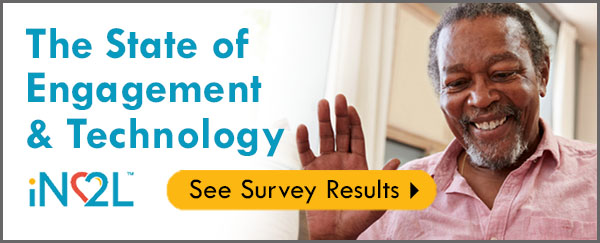By Susan Saldibar
Those first, tentative steps toward bringing people physically back together again are going to be the hardest. Maybe you’ve already started. And hopefully, it’s going well. But the real test will be reaching those really reluctant residents. The ones we worry so much about who do little more than crack their doors open. But who can blame them?
I spoke recently with Lisa Taylor, CEO of iN2L (a Senior Living Foresight partner) about the terrible impact that social isolation is having on the health and well-being of residents who are still hesitant about venturing out of their apartments or rooms. Most agree that, with social distancing and safety precautions in place, it makes sense to begin allowing small groups of three to five residents to engage in communal activities.
A Key Role in Bringing People Back Out of Their Rooms
“As technology providers, we are well aware of the power of tablets and smart TVs to connect residents to family members and activities,” Lisa tells me. “But nobody wants to see technology keeping people isolated in their rooms and apartments.”
iN2L developed its large touch-screen interactive engagement system to encourage group engagement. But who knew that it would play such a key role in bringing people back together again during a pandemic? Especially when the focus has been on engaging residents individually. I asked Lisa to weigh in on how it’s working out for communities and if those hard-to-reach residents are finally feeling less isolated.
Staff and Volunteers Can Run Engagement Programs Without Any Training
First, Lisa is quick to note that for all gatherings, of any type, safety needs to be the top priority, with adherence to CDC guidelines. That said, she is heartened to see communities finding ways to bring small groups of people together safely. “What they are doing is rolling our larger group systems out into hallways and open, less trafficked, areas and then inviting a few residents at a time to partake in activities,” she says. And, from what she’s hearing, those interactions are indeed helping to reduce anxiety and uplift the spirits of residents. Who, for the last several months, have felt isolated and out of touch with those around them.
What’s cool about iN2Ls systems is that they are really easy to interact with, even for those who have never used iN2L before. “It’s all-hands-on-deck these days, which means people are wanting to use iN2L who haven’t before,” Lisa says. “In a way, these are ‘quaranteams’ — staff members, volunteers, and anyone pitching in to lend help wherever and whenever needed,” she adds.
The iN2L user interface was engineered to make that easy, Lisa tells me. No learning curve needed. “We have a ‘quick start’ menu that allows you to immediately run an activity program with easy-to-follow steps,” she explains. “We want to make it possible for anyone to jump in and do a pop-up activity when the occasion presents itself.” And, what I really like is that the screens are built to work outdoors as well. This really presents the opportunity to bring people together outdoors with fresh air.
We All Crave Human Contact
All this hasn’t just come out of thin air, Lisa tells me. She’s spent the last several months listening to senior living leadership and working with communities to learn how they can use this technology to help. What families want to know these days is what communities are doing to safely re-connect residents to those around them. And this is one way to show that. Especially if they can coax out those residents who have been especially fearful of leaving their rooms and apartments.
I would imagine that rolling an iN2L system loaded up with its 4,000 plus activities through the halls and even outside into the courtyard would be a sight for sore eyes. And it may be just what communities need to help re-energize the staff as well as residents. Everyone wants to get back a sense of normality. This solution certainly helps. “We all crave human contact,” Lisa says. “We’re so glad that our system is helping to make it happen.”
Find out how your peers are approaching engagement and technology. You can download a copy of iN2L’s recent research report here.








